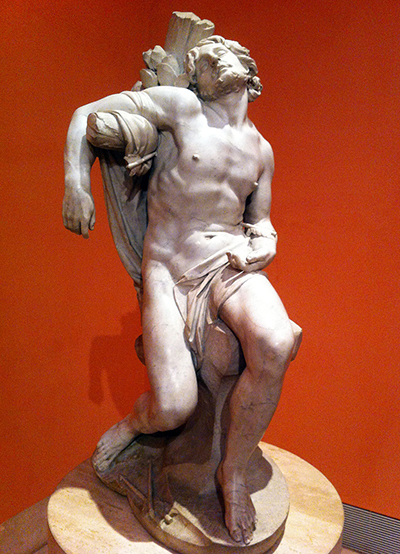This marble sculpture was executed during 1617 and 1618 and is smaller compared to life-size statues. The sculpture was commissioned by Lorenzo`s benefactor Cardinal Maffeo Barberini, who became pope in the year 1623 as Urban VIII.
Initially, this sculpture was thought to have been created for the chapel of the family of Barberini in Sant'Andrea Della Vall church. This church was built exactly on the spot where the body of Saint Sebastian had been recovered, but there is no evidence of its location there.
The sculpture was initially recorded in 1628 when it was transferred from the family home on Via dei Giubbonari to a new building on Via Delle Quattro Fontane. From this new building, this sculpture was taken by Maffeo's nephew, Cardinal Francesco Barberini. This family owned it until 1935 when Heinrich Thyssen-Bornemisza acquired it, and other notable paintings, from their heirs. A document dated 29 Dec 1617 recording payment of 50 escudos from Maffeo Barberini to the father of Gian Lorenzo has enabled the dating of this.
This sculpture shows Saint Sebastian, a Christian martyr, pinned to a tree and his flesh stuffed with arrows. It represents the period before Saint Irene arrives. The tormentors have deserted the place of execution, leaving the saint dying from the arrow wounds. Lorenzo places the depiction on a rock and he uses the trunk of the tree where Saint Sebastian is martyred as the support for his back. The right arm of the saint, still showing one of the bindings, lies on a dry branch. The saint's left leg is placed in front of him in order to prop up his body. His other arm hangs parallel to the tree trunk with his hand lying on his thigh.
This arm also appears to show an abandonment just like the right leg. This saint is posing in a precarious, delicate balance which has been accredited to the transformation he is experiencing. The handling of the saint`s face which has a calm expression and parted lips and closed eyes, and the accurately sculpted veins, as well as tense muscles of his body, are all a significant reflection of the comprehensive study Lorenzo made of the moments between Saint Sebastian`s life and death.
Lorenzo drew inspiration from the works of Michelangelo and the models of the Passion of Christ. Critics have discovered two unique pieces by the master on which this art could be based. One of them is the Vatican Pietà and the other one in the Museo dell’Opera del Duomo in Florence. Saint Sebastian comes chronologically after Saint Lawrence on the Gridiron which is in the Contini-Bonacossi Collection and before the group of Ascanius, Anchises and Aeneas in the Galleria Borghese. This sculpture is currently on temporary loan to the Museo Nacional Thyssen-Bornemisza as part of Carmen Cervera's private collection.




